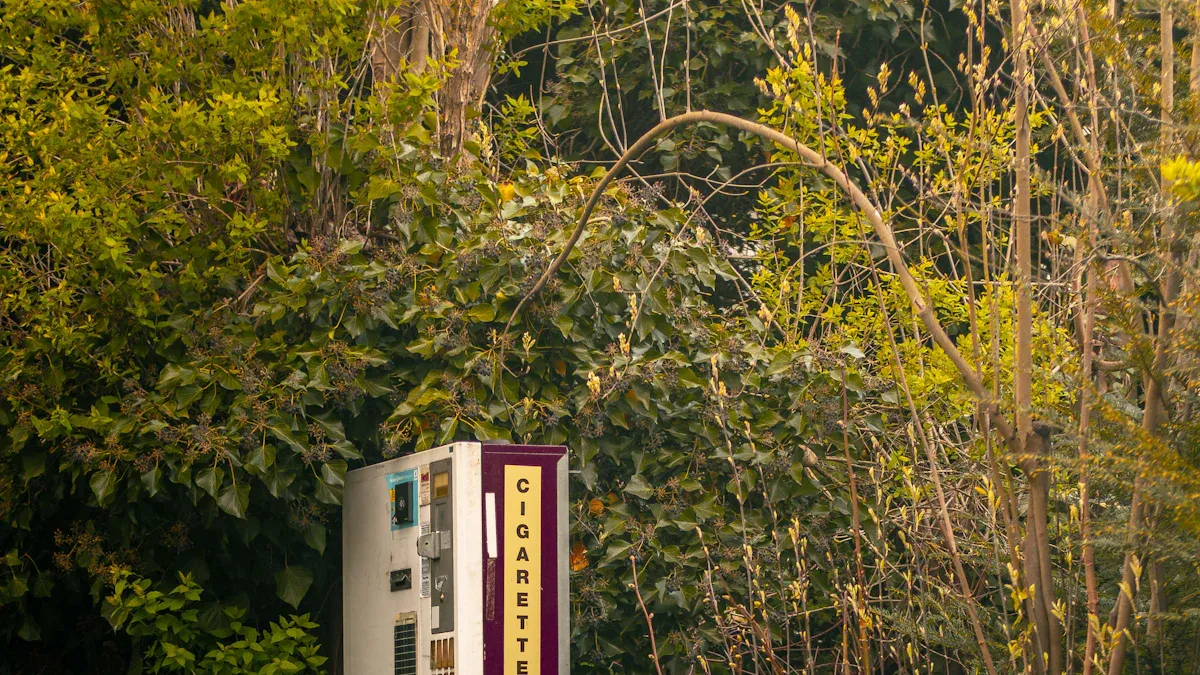The Evolution of Cigarette Vending Machines

Cigarette vending machines have changed greatly since their invention. People often wonder what drives these changes over time. The story of these machines reflects shifts in technology, law, and social habits. Their history shows how a simple vending machine can become a symbol of larger trends in society.
The evolution of cigarette vending machines offers a window into how culture and technology shape everyday life.
Key Takeaways
Cigarette vending machines started in the early 1900s and made buying cigarettes quick and easy without needing a clerk.
These machines became popular in public places like diners and bars, symbolizing convenience and self-service in American culture.
Laws and health rules now limit cigarette vending machines to protect young people from easy access to tobacco.
Modern machines use digital technology and age verification to follow laws and keep sales safe.
Vintage cigarette vending machines are now collectibles and creative projects, showing how old items can find new life today.
Origins
Early Invention
The story of cigarette vending machines begins with a creative spark in the early 1900s. William Briggs filed a patent for the first cigarette vending machine on April 13, 1909. This patent, which can still be found online, marks a key moment in vending machine history. Briggs did not stop at just inventing the machine. He worked hard to market his idea to major tobacco companies. He also defended his patent in court, showing his belief in the future of this invention. News articles from the time describe how Briggs continued to improve his designs and stayed active in the business world. His efforts helped shape the early days of vintage cigarette vending machines.
Briggs’ original machine was simple but effective. It could deliver a box of cigarettes to a customer with just a coin. This single cigarette vendor made buying cigarettes quick and easy. People no longer needed to wait for a store clerk. The invention changed how people thought about buying tobacco products. It also set the stage for more advanced machines in the years to come.
The first cigarette vending machine showed how technology could make everyday life more convenient.
1920s Tabletop Machines
By 1928, tabletop cigarette vending machines started to appear in public places. These vintage cigarette vending machines became popular in restaurants, cafes, and hotels. Their small size made them easy to place on counters or tables. People enjoyed the freedom to buy cigarettes without asking for help. The machines offered a new level of privacy and speed.
The rise of these machines marked a turning point in vending machine history. More people began to see cigarette vending machines as a normal part of daily life. The popularity of vintage cigarette vending machines grew quickly. This growth set the stage for even more changes in the decades that followed.
Rise of Cigarette Vending Machines

Mid-20th Century Growth
During the mid-20th century, vintage cigarette vending machines became a common sight in diners, cafes, restaurants, and many public spaces. Their popularity grew quickly as more people began to smoke and seek convenient ways to buy cigarettes. The machines offered a simple solution for busy customers who wanted to purchase cigarettes without waiting in line or talking to a clerk.
Several factors fueled this rapid growth:
A large smoker population and investments in pubs and nightclubs drove the global market.
The ease of access and the rise of intelligent vending machines helped retailers understand customer behavior.
The automatic segment grew fastest, thanks to new technologies that made instant purchases possible.
Pubs and nightclubs held the largest market share, supported by the growing nightlife trend.
North America led the market, with growth driven by rising disposable income, population increases, and more recreational activities.
Smart vending machines began to include digital advertising, content management, and real-time sales data analysis.
Retailers benefited from data collection and analysis, which improved product quality and market outlook.
Historical records show that entrepreneurs like Robert Zemon Greene placed thousands of vintage cigarette vending machines in department stores, theaters, and transit hubs. These machines became a staple in American life, especially during the 1970s and 1980s. The market size for cigarette vending machines grew from about USD 1.23 billion in 2022 to a forecasted USD 1.85 billion by 2030, showing a steady increase in demand.
The evolution of these machines also reflected changes in consumer habits. People wanted faster, easier ways to buy products. The introduction of cashless payment systems and remote monitoring made the machines even more appealing. During the COVID-19 pandemic, touchless vending solutions became more popular, showing how technology continued to shape the market.
Cultural Symbol
Vintage cigarette vending machines did more than just sell cigarettes. They became symbols of convenience and self-service in American culture. Their presence in diners, bars, and nightclubs showed how society valued quick, automated purchases. People could buy cigarettes at any time, day or night, without needing help from staff.
William H. Rowe's 1926 design overcame early problems like counterfeit coins and set the standard for the industry.
Entrepreneurs expanded the reach of these machines, making them icons of modern convenience.
The shift from 17th-century coin-operated dispensers in England to advanced 1920s machines showed a long-standing demand for easy, automated buying.
By the late 1920s and 1930s, vending machines became widespread, normalizing self-service retail and reinforcing the idea of convenience.
In the 1970s and 1980s, cigarette vending machines offered affordable prices and easy access. Many people remember seeing these machines in restaurants and public places, where they stood as reminders of changing times. The machines reflected broader trends in vending machine history, showing how technology and culture worked together to shape everyday life.
Vintage cigarette vending machines stand as lasting symbols of a time when convenience and self-service became central to American consumer culture.
Regulation and Cigarettes
Legal Restrictions
Concerns about underage buyers have shaped the rules around cigarette vending machines. Lawmakers and health officials noticed that minors could easily buy cigarettes from these machines. To protect young people, governments created strict laws and rules.
Some of the main legal documents and regulations include:
The Public Health Service Act requires states to enforce laws that stop tobacco sales to minors. This includes sales through vending machines.
The Department of Health and Human Services asks states to do random inspections, sometimes called "sting" operations, to check if stores and machines follow the rules.
The FDA has proposed rules that ban vending machine sales in many places and stop the sale of single cigarettes.
States can choose how to enforce these rules. They may use licensing systems, civil penalties, or special funds to help with enforcement.
Research reports, like the "1994 State of the Industry Report" and the Inspector General's report, show how these rules affect the vending machine business and how well enforcement works.
The Department of Health and Human Services allows states to pick the best ways to enforce the rules, instead of forcing one strict method.
Random inspections and sting operations work well, but states can use other methods if they want.
The FDA's proposals include vending machine bans as an option, but states do not have to use them.
The table below shows some of the main legal restrictions on cigarette vending machines:
Citation | Summary of Legal Restrictions on Cigarette Vending Machines |
|---|---|
§1140.16(c) | Prohibits sale of cigarettes and smokeless tobacco via vending machines except in facilities where no person under 18 is present or permitted. Retailers must ensure compliance. |
§1140.14(c) | Requires retailers to sell cigarettes only in direct, face-to-face exchanges, prohibiting vending machines except as allowed in §1140.16(c)(2)(ii). |
§1140.1 | Establishes the scope under the Federal Food, Drug, and Cosmetic Act, defining the legal basis for restrictions on sale and distribution of cigarettes and smokeless tobacco. |
Final Rule Overview | Prohibits sale to persons under 18, restricts vending machine sales to adult-only facilities, mandates age verification, and limits marketing and advertising to protect minors. |
The Family Smoking Prevention and Tobacco Control Act of 2009 made a big impact on cigarette vending operations. This law banned the sale of single cigarettes across the country starting in 2011. It also stopped the sale of flavored cigarettes and those labeled as light or low tar. After the law took effect, vendors were much less likely to sell banned products. In 2011, vendors were 0.40 times as likely to sell flavored or light/low tar cigarettes compared to 2009. Still, some violations continued. About 28.6% of U.S. vendors sold flavored cigarettes, and 42.9% sold light/low tar cigarettes. The law also led to the Prevent All Cigarette Trafficking Act, which banned cigarette deliveries through the U.S. Postal Service. These changes made it harder for vending machines to offer banned products and helped reduce access for minors.
Social Attitudes
Society's views on cigarette vending machines have changed over time. Many people now see these machines as a risk for youth smoking. Studies have measured how people feel about tobacco and vending machines by asking questions like, "Should cigarette vending machines be totally prohibited?" These questions help show how public opinion has shifted.
Surveys show that more people agree with banning cigarette vending machines to protect young people.
Researchers found that social norms around tobacco have changed, with more support for strict rules on tobacco sales.
Studies in Australia looked at owners and managers of venues that sell tobacco only through vending machines. Most said tobacco sales were not important for their business. Only a few worried about losing customers if they stopped selling tobacco.
These findings suggest that removing cigarette vending machines does not hurt most businesses. This supports public health efforts to limit tobacco access.
In vending machines recent history, these changes in law and public opinion have led to fewer machines in public places. Many states now allow cigarette vending machines only in adult-only locations. Age verification and other safety steps have become common. The story of cigarette vending machines shows how society can change its mind about what is safe and acceptable.
Public health laws and changing attitudes have worked together to limit the reach of cigarette vending machines and protect young people from tobacco.
Vending Technology Evolution

Mechanical to Digital
Cigarette vending machines have changed a lot since their early days. The first machines used simple mechanical parts to deliver products. Over time, manufacturers added new features to make these machines smarter and more efficient. Early records show that the Thomas Adams Gum Company built the first U.S. vending machine in 1888. This machine worked with coins and levers. Later, trade stimulators added mechanical incentives to attract customers.
Today, vending technology has moved far beyond these early designs. Companies now use digital systems with touchscreens, sensors, and embedded computers. Many machines connect to the internet and use real-time data to track inventory and maintenance needs. The National Automatic Merchandising Association helped set standards like the MDB (Multidrop Bus) protocol, which lets different parts of a vending machine communicate. Market research shows a clear shift from mechanical systems to smart, connected digital vending machines.
New vending technology uses AI, IoT, and automation to improve performance.
Predictive analytics and machine learning help operators understand customer habits.
Digital signage and cashless payments make modern designs more user-friendly.
The move from mechanical to digital vending technology has made cigarette vending machines more reliable and easier to manage.
Age Verification
Modern vending technology must meet strict rules to prevent underage sales. Companies use advanced age verification systems to follow the law and protect young people. These systems include ID scanners, biometric checks, and mobile-enabled verification.
ID scanners read government-issued IDs and check for security features like barcodes and holograms.
Biometric methods use fingerprints or facial recognition to confirm a person's age.
Mobile apps can store verified age data and allow quick checks with NFC or QR codes.
AI-powered systems estimate age in real time and can cross-check with databases where allowed.
These features make cigarette vending machines safer and more secure. Operators must keep systems updated to meet changing laws. They also need to protect user privacy and keep machines running smoothly. Best practices include regular maintenance, clear instructions, and strong data security.
Operators who use advanced age verification show responsibility and build trust with customers and regulators.
Legacy and Modern Use
Collectibles
Vintage cigarette vending machines have become prized collectibles for many people. Collectors search for these machines because they represent a unique part of American culture. Some machines feature bright colors, chrome details, and logos from famous tobacco brands. These details make each machine special and interesting to display.
Tony Hyman, a well-known collector of cigar memorabilia, highlights the important role collectors play in saving tobacco-related items. He has spent years building a large collection and documenting the history of tobacco packaging and memorabilia. His work shows how collectors help preserve objects that might otherwise disappear. Vintage cigarette vending machines, like other tobacco artifacts, gain value because they connect people to the past. Museums and private collections often include these machines to show changes in design and technology over time.
Collectors often look for machines from the 1940s and 1950s. These models show the style and craftsmanship of their era. Some collectors restore machines to working condition, while others keep them as they were found. The search for rare or unusual models adds excitement to the hobby.
Repurposed Machines
Many people now find new uses for vintage cigarette vending machines. Artists and business owners see these machines as blank canvases for creative projects. Some turn them into art installations, using the original structure but adding new colors or designs. Others convert them to sell products like snacks, art prints, or small toys.
Repurposing gives old machines a second life. It also keeps them out of landfills and helps people appreciate their design. In some cities, vintage cigarette vending machines appear in galleries, coffee shops, or even hotels. These machines attract attention and spark conversations about the past.
Vintage cigarette vending machines hold a special place in vending machine history. They remind people of a time when self-service and convenience shaped public spaces. Today, they serve as both collectibles and creative projects, showing how objects from the past can find new meaning in modern life.
Cigarette vending machines have changed from simple coin-operated dispensers in the 17th century to symbols of convenience and modern design. Their journey shows how technology, law, and culture shape everyday life.
These machines once stood in diners and bars, making cigarettes easy to buy and helping brands become famous.
Stricter rules and health campaigns led to fewer machines, but vintage models now serve as art displays and collectibles.
New vending technology, like AI-powered stores, continues to reflect society’s changing needs and values.
FAQ
How did cigarette vending machines work in the past?
Early machines used simple levers and coin slots. A person inserted a coin, pulled a handle, and the machine released a pack of cigarettes. These machines did not check age or identity.
Why did many places remove cigarette vending machines?
Lawmakers and health groups wanted to stop young people from buying cigarettes easily. New rules required age checks. Many businesses removed the machines to follow these laws and protect minors.
Are cigarette vending machines still used today?
Some countries and adult-only venues still use them. Modern machines include age verification tools like ID scanners. Most public places in the United States no longer have these machines.
What makes vintage cigarette vending machines collectible?
Collectors value these machines for their unique designs, bright colors, and historical logos. Many see them as symbols of a different era. Restored machines often become display pieces in homes or museums.
Can old cigarette vending machines be used for other products?
Yes! People repurpose vintage machines to sell snacks, art, or small toys. Artists and business owners enjoy giving these machines new life and creative uses.
See Also
How Vending Machines Transformed From Snacks To Smart Devices
Zyn Vending Machines Revolutionize Convenience And Nicotine Access
Tracing The Development Of MP3 Music Vending Machines
Mountain Dew Vending Machines Journey From Classic To Cutting-Edge
Cash Vending Machines Progress From Coins To Digital Transactions
